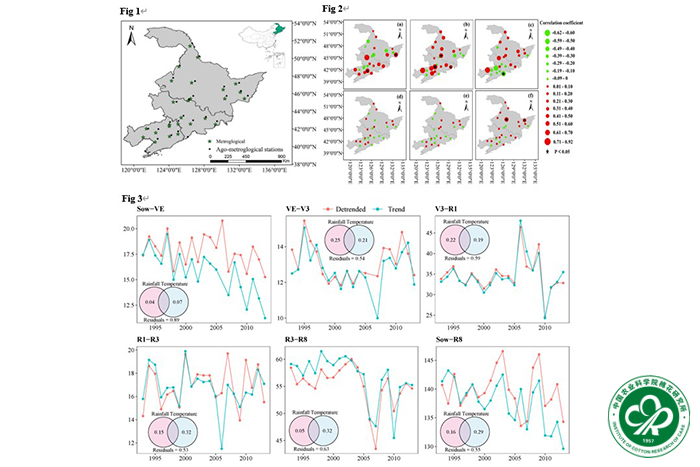- Location : Home» Newsroom
Study revealed the spatiotemporal characteristics and response mechanisms of climate change on soybean phenology
Study revealed the spatiotemporal characteristics and response mechanisms of climate change on soybean phenology
From: Cotton Smart Cultivation TeamAuthor: Xin Minghua
Recently, a team of researcher Li Yabing from the Institute of Cotton Research, Chinese Academy of Agricultural Sciences (CAAS) conducted a study on soybean phenology in China, revealing the spatial and temporal characteristics of soybean phenology and the relationship between soybean phenology and climate change, and found that soybean sowing, seedling emergence, the third true-leaf stage, flowering, and podding are generally delayed in the three northeastern provinces, but the maturity and harvesting period is advanced. Soybean sowing-seedling, seedling-third true leaf, podding-harvesting and the whole growing period were shortened by an average of 1.72, 0.02, 1.64 and 2.05 days per decade, while the third true leaf-flowering-podding durations were lengthened by an average of 0.80 and 0.08 days per decade. The results provide a theoretical basis for rational planning of soybean production to cope with climate change. The results of the study were published as "Soybean phenological changes in response to climate warming in three northeastern provinces of China" in the prestigious international journal Field Crops Research. The results of the study were published in the prestigious international journal "Field Crops Research" (IF=6.145, Agricultural and Forestry Science Zone 1 TOP).
Phycology refers to cyclical and seasonal life cycle events, which are growth rhythms of crops adapted to seasonal environmental changes over time. During the past two decades, global climate change, characterized mainly by temperature and rainfall, has had a significant impact on the phenological periods of different crops in the world today. Therefore, it is important to study the spatial and temporal characteristics of crop phenology and its response mechanism to gain a deeper understanding of the relationship between crop phenology and climate change.
In this study, by investigating the relationship between the fertility period of soybean and climate change over the past 21 years in the three northeastern provinces, as well as the spatial and temporal variation characteristics of soybean at different fertility periods, it was found that the increase in mean atmospheric temperature accelerated the growth of soybeans, and shortened the full-life span of soybeans. In addition, the harvesting period of soybean was advanced because of the decrease in rainfall and the increase in temperature. At the same time, the uneven distribution of precipitation and the temporal and spatial variations in precipitation patterns will further increase the risk of extreme meteorological hazards. Therefore, in order to cope with climate change and reduce the sensitivity of agricultural production to climate change, it is necessary to adjust the sowing period, harvest late at the right time, strengthen the cultivation of high temperature and drought-prone varieties, and adopt appropriate cultivation techniques and field management measures. The results of this study provide evidence for the relevant responses of soybean phenology to climatic factors, and provide a scientific basis for the subsequent adaptation of soybean to global climate change and the realization of sustainable management of production.
Assistant researcher Xin Minghua and doctoral student Zhang Zhenggui from China Cotton Research Institute are the first authors of the paper。 This research was supported by the National Key Research and Development Program of China (2020YFD1001000), the National Natural Science Foundation of China (31701389), and the Special Funds for Basic Scientific Research Operations of Research Institutes of Public Interest at Central Level (1610162022032, 1610162021037).
Original Link:https://doi.org/10.1016/j.fcr.2023.109082
